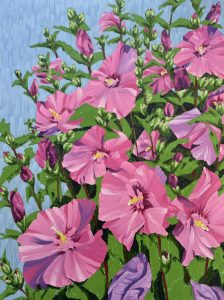
 Imagine you are in the Louvre viewing different pieces of art. You notice that some people stand and look at a painting for quite a long time before moving on. What is it they are looking at? Why is it taking them so long? What are they thinking as they view the art? Now imagine viewers enjoying your piece of art. What must you consider to engage them and prolong their enjoyment?
Imagine you are in the Louvre viewing different pieces of art. You notice that some people stand and look at a painting for quite a long time before moving on. What is it they are looking at? Why is it taking them so long? What are they thinking as they view the art? Now imagine viewers enjoying your piece of art. What must you consider to engage them and prolong their enjoyment?
We admire an artist’s technical skills such as applying paint to canvas. But technical mastery is not enough to engage the viewer for very long. The design or composition of the piece, as
well as the content itself, is just as important. So how does one tackle composition? How do you create your artwork to command maximum attention?
With the possible exception of commissioned portraits, being an artist is not about slavishly copying what we see in a photograph or a real life scene. Recognize that it’s next to impossible to find the perfect scene or the perfect photograph which provides you with ideal composition. You need to manipulate things to communicate the essence of what you see in the best possible way. Most of the time that involves isolating a portion of the image either by viewfinder in the case of plein air painting or by cropping a photo to make the most interesting composition that communicates what we want to convey. Often it means removing unnecessary details or moving things around – moving a tree here or a building there, or changing the direction of a path or stream … whatever needs to be done to make the most pleasing design to hold the viewer’s attention. Even moving a piece of jewelry in a portrait or a piece of furniture in an indoor scene can create added interest to a piece and guide the viewer’s eyes around the picture plane.
It is helpful to start the design process by deciding what is the most important spot in the drawing or painting – where you want the viewer’s eye to go first. This will be your “focal point”. It could be a building, an animal, a person or a specific thing but more likely it will simply be a space that you have determined deserves the greatest attention. It could be the juncture of a strong horizontal line and a strong vertical line. Maybe it’s a patch of sunlight in a forest. Maybe it’s a rich colour you want to highlight. Once you have decided what is most important, everything else in the picture plane should be subordinated to it.
Then determine where in the picture plan you want to place your focal point. Do one or more thumbnail sketches to scope out where everything should be placed. Tradition recommends that you use the Rule of Thirds – that is, divide the picture plane into thirds horizontally and vertically which results in nine boxes. Rather than placing the focal point in the centre of the picture, consider placing it on or just outside one of the intersections of the lines. This adds to the “tension” of the scene which keeps the viewer engaged longer.
Since you don’t want the viewer to be stuck at the focal point and miss all the wonderful artwork you have done around it, you need to design your composition to guide the viewer around the picture plane. A couple of ways to do this are by
Once you have decided on the composition, carry the concept forward by using various technical devices to highlight the focal point and subordinate the other elements. Typically the focal point should have the biggest contrast in tonal values (light and dark), the greatest detail and the hardest edges. Areas farther away from the focal point should have less tonal contrast, less detail and softer edges.
Please contact me at pugpillowart@gmail.com for clarification about or comments on any of the above information.